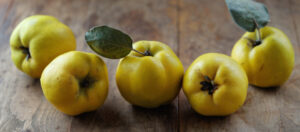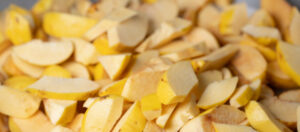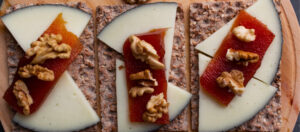Posted in: Market Bounty
Quince’s zingy, tart flavor — a combination of guava, pineapple, apple, and pear—adds to Autumn and Winter baked goods & sauces and balances roasted meat. They don’t turn to mush when cooked, so quinces are the perfect addition to the winter stews and braises.
Not familiar with quince, want to learn more or need some inspo? Read on…
FACTS

- Quince is a hard, aromatic, bright golden-yellow fruit from the deciduous Cydonia oblonga tree. It is similar in size and color to a Barlett pear, except a little bumpier.
- Quince belongs to the rose family (Rosaceae), whose members include apples, pears, quinces, medlars, loquats, almonds, peaches, apricots, plums, cherries, strawberries, blackberries, raspberries, and yes, roses.
- Its season generally runs from late September to early January.
- Native to Iran, Turkey, and the Crimean Peninsula, its cultivation can be traced back 4,000 years to ancient Greece and Rome, where it symbolized love & fertility and played an essential role in wedding celebrations.
- Varieties grown in North America typically cannot be eaten raw — they are too astringent and sour.
- The “Pineapple” quince is the most common variety in Portland and the surrounding region.
- Some varieties grown in Iran and other warm areas can be eaten raw.
- Quince is high in vitamin C and fiber, with trace amounts of copper, iron, and potassium.
PREPARATION

- Quince is best poached with a sweetener. It can also be roasted, stewed, pureed, baked, dried, or grilled.
- Quince contains a lot of pectin, a naturally occurring starch, that makes it an excellent preserve.
- When cooked, the flesh can take on a pink color.
- Quince is also used in liqueur and brandy.
- When quince is ripe, it reaches a bright yellow hue with little specks of brown and gives off a fragrant, heady aroma of apple, rose, citrus & vanilla.
- The peel of a quince is thin, like an apple, and can be peeled with a vegetable peeler on the whole fruit.
- Then, cut it lengthwise (through the core) into six wedges with a large chef’s knife. Carefully remove the core with a sturdy, small paring knife.
- Note that cut-up quince oxidizes quickly. Immediately drop the cut pieces into a bowl of water and lemon juice to prevent browning.
RECIPES

- Poached QuinceDelicious on its own, this can also be enjoyed on yogurt, ice cream, pancakes, waffles, or oatmeal.
- Here’s another easy recipe but this one uses more aromatics.
- Quince Soda Syrup Wonderful in sparkling water, cocktails and mocktails.
- Quince Paste (Dulce de Membrillo) Pair this traditional Spanish paste with cheese from any of our fabulous cheese vendors (Fraga Farm, Jacob’s Creamery, Lady Lane Farm, Portland Creamery, Briar Rose Creamery, and Vtopia Artisan Cheeses) and crackers from Robyn’s Craft Bakehouse.
- Quince Jam This article also provides multiple uses for the jam.
- Quince Brandy
STORAGE
- Fresh quince can be stored on a kitchen countertop. However, once it gives off a heady, fruity aroma, it’s best to cook it before it rots.
- Fresh quince can also be wrapped in a plastic bag and refrigerated for up to two months.
- Poached or stewed quince can be stored in its poaching liquid in a refrigerator for a week or two or frozen for months.
- Like any preserved/canned food, quince paste, jam, and jelly are shelf-stable when unopened. Once opened, store it in the refrigerator.
We hope you take advantage of the quince season while it’s here!
